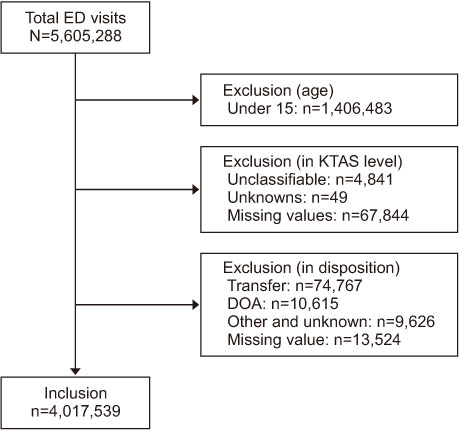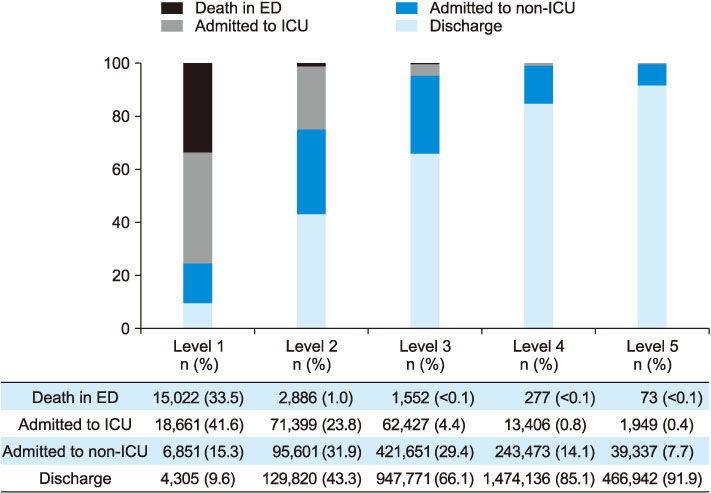J Korean Acad Nurs.
2019 Feb;49(1):26-35. 10.4040/jkan.2019.49.1.26.
Evaluation of Validity of the Korean Triage and Acuity Scale
- Affiliations
-
- 1Department of Nursing, Konkuk University, Cheongju, Korea.
- 2Department of Emergency Department, Konkuk University Medical Center, Seoul, Korea. 20050058@kuh.ac.kr
- KMID: 2440384
- DOI: http://doi.org/10.4040/jkan.2019.49.1.26
Abstract
- PURPOSE
The aim of this study was to identify the predictive validity of the Korean Triage and Acuity Scale (KTAS).
METHODS
This methodological study used data from National Emergency Department Information System for 2016. The KTAS disposition and emergency treatment results for emergency patients aged 15 years and older were analyzed to evaluate its predictive validity through its sensitivity, specificity, positive predictive value, and negative predictive value.
RESULTS
In case of death in the emergency department, or where the intensive care unit admission was considered an emergency, the sensitivity, specificity, positive predictive value, and negative predictive value of the KTAS were 0.916, 0.581, 0.097, and 0.993, respectively. In case of death in the emergency department, or where the intensive or non-intensive care unit admission was considered an emergency, the sensitivity, specificity, and positive predictive value, and negative predictive value were 0.700, 0.642, 0.391, and 0.867, respectively.
CONCLUSION
The results of this study showed that the KTAS had high sensitivity but low specificity. It is necessary to constantly review and revise the KTAS level classification because it still results in a few errors of under and over-triage. Nevertheless, this study is meaningful in that it was an evaluation of the KTAS for the total cases of adult patients who sought help at regional and local emergency medical centers in 2016.
MeSH Terms
Figure
Cited by 2 articles
-
Pediatric Emergency Department Utilization and Coronavirus Disease in Daegu, Korea
Kyung Mi Jang, Ji Young Ahn, Hee Joung Choi, Sukhee Lee, Dongsub Kim, Dong Won Lee, Jae Young Choe
J Korean Med Sci. 2020;36(1):e11. doi: 10.3346/jkms.2021.36.e11.Long-term impact of coronavirus disease 2019 pandemic on emergency department utilization in a metropolitan emergency department in Korea
Seung Yeon Hwang, Jae Kwang Lee, Hyun Sik Ryu, Seong Soo Park, Jun Young Choi, Hye Ji Lee, Seung Ho Hur, Yeong Geun Park, Hyun Soo Choi
Pediatr Emerg Med J. 2021;8(2):57-65. doi: 10.22470/pemj.2021.00346.
Reference
-
1. National Emergency Medical Center. 2016 Annual report of Korean emergency medicine. Seoul: National Emergency Medical Center;2017. 10. Report No.: 11-1352000-001248-10.2. Carter EJ, Pouch SM, Larson EL. The relationship between emergency department crowding and patient outcomes: A systematic review. Journal of Nursing Scholarship. 2014; 46(2):106–115. DOI: 10.1111/jnu.12055.
Article3. Fitzgerald G, Jelinek GA, Scott D, Gerdtz MF. Republished paper: Emergency department triage revisited. Postgraduate Medical Journal. 2010; 86(1018):502–508. DOI: 10.1136/pgmj.2009.077081rep.
Article4. Fernandes CM, Tanabe P, Gilboy N, Johnson LA, McNair RS, Rosenau AM, et al. Five-level triage: A report from the ACEP/ENA Five-level Triage Task Force. Journal of Emergency Nursing. 2005; 31(1):39–50. DOI: 10.1016/j.jen.2004.11.002.
Article5. Australian Government Department of Health. Emergency triage education kit [Internet]. Canberra: Australian Government Department of Health;2013. cited 2018 Jan 20. Available from: http://www.health.gov.au/internet/main/publishing.nsf/content/casemix-ed-triage+review+fact+sheet+documents.6. Beveridge R, Ducharme J, Janes L, Beaulieu S, Walter S. Reliability of the Canadian emergency department triage and acuity scale: Interrater agreement. Annals of Emergency Medicine. 1999; 34(2):155–159. DOI: 10.1016/S0196-0644(99)70223-4.
Article7. Tanabe P, Travers D, Gilboy N, Rosenau A, Sierzega G, Rupp V, et al. Refining Emergency Severity Index triage criteria. Academic Emergency Medicine. 2005; 12(6):497–501. DOI: 10.1197/j.aem.2004.12.015.
Article8. Mackway-Jones K, Marsden J, Windle J. Emergency triage: Manchester triage group. 3rd ed. Oxford: John Wiley & Sons;2013. p. 185.9. National Emergency Medical Center. 2016 National Emergency Department Information System (NEDIS) statistics annual report. Seoul: Ministry of Health and Welfare, National Emergency Medical Center;2017. 07. Report No.:11-B552657-000007-10.10. The National Law Information Center. Emergency medical service act (enforcement regulations): Article 18-3 [Internet]. Sejong: The National Law Information Center;c2016-2018. cited 2018 Jan 20. Available from: http://www.law.go.kr/법령/응급의료에%20관한%20법률%20시행규칙.11. Park J, Choi H, Kang B, Kim C, Kang H, Lim T. A nationwide survey of Korean emergency department triage systems and scales; A first step towards reform of the emergency medical service system. Journal of the Korean Society of Emergency Medicine. 2014; 25(5):499–508.12. Ministry of Health and Welfare. Korean Triage and Acuity Scale adult/child training program: Participant's manual version 1.0 [Internet]. Sejong: The Korean Society of Emergency Medicine;c2014. cited 2018 Jan 20. Available from: http://www.prism.go.kr/homepage/entire/retrieveEntireDetail.do?pageIndex=1&research_id=1351000-201400241&left-MenuLevel=160&cond_research_name=한국형+중증%.13. Lee I, Kim O, Kim C, Oh J, Lim T, Lee J, et al. Validity analysis of Korean triage and acuity scale. Journal of the Korean Society of Emergency Medicine. 2018; 29(1):13–20.14. Iserson KV, Moskop JC. Triage in medicine, part I: Concept, history, and types. Annals of Emergency Medicine. 2007; 49(3):275–281. DOI: 10.1016/j.annemergmed.2006.05.019.
Article15. Bullard MJ, Musgrave E, Warren D, Unger B, Skeldon T, Grierson R, et al. Revisions to the Canadian Emergency Department Triage and Acuity Scale (CTAS) guidelines 2016. Canadian Jornal of Emergency Medicine. 2017; 19(S2):S18–S27. DOI: 10.1017/cem.2017.365.
Article16. Oh J. How do I use Korean Triage and Acuity Scale (KTAS)?: Questionnaire survey for classification person in 1 year after Project. Paper presented at: 2017 The Korean Society of Emergency Medicine Spring Conference. 2017 Apr 20-21; Gwangju, Korea.17. Aeimchanbanjong K, Pandee U. Validation of different pediatric triage systems in the emergency department. World Journal of Emergency Medicine. 2017; 8(3):223–227. DOI: 10.5847/wjem.j.1920-8642.2017.03.010.
Article18. Zachariasse JM, Seiger N, Rood PPM, Alves CF, Freitas P, Smit FJ, et al. Validity of the Manchester Triage System in emergency care: A prospective observational study. PLoS One. 2017; 12(2):e0170811. DOI: 10.1371/journal.pone.0170811.
Article19. Lee JY, Oh SH, Peck EH, Lee JM, Park KN, Kim SH, et al. The validity of the Canadian Triage and Acuity Scale in predicting resource utilization and the need for immediate life-saving interventions in elderly emergency department patients. Scandinavian Journal of Trauma, Resuscitation and Emergency Medicine. 2011; 19:68. DOI: 10.1186/1757-7241-19-68.
Article20. Kim JH, Kim JW, Kim SY, Hong DY, Park SO, Baek KJ, et al. Validation of the Korean triage and acuity scale compare to triage by emergency severity index for emergency adult patient: Preliminary study in a tertiary hospital emergency medical center. Journal of the Korean Society of Emergency Medicine. 2016; 27(5):436–441.21. Shin JW, Lee SH, Lee DS, Kim HB, Jo YM, Bae BG, et al. Validity of the newly developed Five Level Pediatric Triage System implemented in a children's hospital emergency department. Journal of the Korean Society of Emergency Medicine. 2017; 28(6):557–563.22. Kuriyama A, Urushidani S, Nakayama T. Five-level Emergency Triage Systems: Variation in assessment of validity. Emergency Medicine Journal. 2017; 34(11):703–710. DOI: 10.1136/emermed-2016-206295.
Article23. Jiménez JG, Murray MJ, Beveridge R, Pons JP, Cortés EA, Garrigós JBF, et al. Implementation of the canadian emergency department triage and acuity scale (CTAS) in the principality of Andorra: Can triage parameters serve as emergency department quality indicators? Canadian Journal of Emergency Medicine. 2003; 5(5):315–322.24. Eitel DR, Travers DA, Rosenau AM, Gilboy N, Wuerz RC. The Emergency severity index triage algorithm version 2 is reliable and valid. Academic Emergency Medicine. 2003; 10(10):1070–1080. DOI: 10.1197/S1069-6563(03)00350-6.
Article25. Martins HMG, Cuña LM, Freitas P. Is Manchester (MTS) more than a triage system? A study of its association with mortality and admission to a large Portuguese hospital. Emergency Medicine Journal. 2009; 26(3):183–186. DOI: 10.1136/emj.2008.060780.
Article26. Ministry of Health and Welfare. Standardization study of Emergency Triage System [Internet]. Seoul: The Korean Society of Emergency Medicine;c2012. cited 2018 Jan 20. Available from: http://www.prism.go.kr/homepage/entire/retrieveEntireDetail.do?pageIndex=3&research_id=1351000-201300160&leftMenuLevel=160&cond_research_name=%EC%9D%91%EA%B8%89&cond_research_start_date=&cond_research_end_date=&pageUnit=10&cond_order=3.27. Kennedy K, Aghababian RV, Gans L, Lewis CP. Triage: Techniques and applications in decisionmaking. Annals of Emergency Medicine. 1996; 28(2):136–144. DOI: 10.1016/S0196-0644(96)70053-7.
Article28. The National Law Information Center Emergency medical service act (enforcement regulations): Article 9 [Internet]. Sejong: The National Law Information Center;c2016–2018. cited 2018 Jan 20. Available from: http://www.law.go.kr/법령/응급의료에%20관한%20법률%20시행규칙.29. Lim CY, Park SY, Park KH, Park HY, Kim JE. The predictive factors for hospitalization of nonurgent patients visiting an emergency department in an urban area: A single center study. Journal of the Korean Society of Emergency Medicine. 2018; 29(2):152–159.
- Full Text Links
- Actions
-
Cited
- CITED
-
- Close
- Share
- Similar articles
-
- Abuse of the Korean Triage and Acuity Scale in the assessment of emergency medical facilities
- Validation of the Korean Triage and Acuity Scale Compare to Triage by Emergency Severity Index for Emergency Adult Patient: Preliminary Study in a Tertiary Hospital Emergency Medical Center
- Re-evaluation characteristics of the Korean Triage and Acuity Scale (KTAS): the relationship between overcrowding and KTAS re-evaluation
- Relevance of emergency level assessment by the Korean Triage and Acuity Scale for adult patients in a local emergency medical center
- Appropriateness of triage by emergency medical technician using the Korean Triage and Acuity Scale



